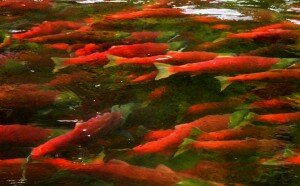 Pretty good string of articles from Mr. Hume these days — salmon are getting some mainstream press. Good to see…
Pretty good string of articles from Mr. Hume these days — salmon are getting some mainstream press. Good to see…
Mark’s article today in the Globe, is based on an article by Elizabeth Pennisi in Science magazine:
The Chilko sockeye is the Michael Phelps of salmon. Once a year, it swims 650 kilometers up British Columbia’s Fraser River, fighting rapids and strong currents, to reach a spot where it can lay and fertilize its eggs. New research reveals that the fish is well-adapted to this journey—it has a bigger, better heart and uses oxygen more efficiently than do other local salmon. And thanks to these attributes, the Chilko sockeye may be more likely than these other fish to survive a warming world.
Not all of the Fraser River’s salmon swim as far as the Chilko sockeye. Some stay relatively close to the coast; others swim a bit farther upstream to spawn. There are so many different migration distances that the fish have split into 100 distinct populations—one of which is the Chilko—with different swimming behaviors and body types.
Hot summers take a toll on these migrations. In 2004, for example, 80% of some salmon populations died of heat stress before reaching their spawning destinations. Water temperatures in the Fraser River have risen 2°C in the past 60 years, and, with global warming, researchers expect even bigger die-offs to come. Erika Eliason, a graduate student at the University of British Columbia, Vancouver, in Canada, wanted to know whether different populations of Fraser River salmon were better than others at handling the heat.
I think this is called local adaptation and demonstrates the importance of biodiversity… not to mention the scary stat that 80% of some salmon populations die en route in the river. First, they dodge all the fisheries, seals, orcas, and pollution of the lower Fraser (not to mention years of the North Pacific…) — then they die en route, simply because the water gets too warm.
It will give those of you comfort to know that pre-season forecasts for this year are looking dismal; however, the Department of Fisheries and Oceans is still floating around various potential scenarios that include harvesting up to 50% of some runs. The hearty Chilko run will most likely be one of those runs with targeted fisheries.
_ _ _ _ _ _ _
Mark Hume in the Globe today:
Sockeye salmon in the Fraser River are facing such critically warm water in the summer that populations will either have to adapt or die as climate change pushes temperatures even higher, according to new research at the University of British Columbia [by Erika Eliason].
With oceans, lakes and rivers warming worldwide, the study holds a warning that fish stocks are facing increasingly dire environmental challenges…
…What Ms. Eliason found was that sockeye, which migrate up to 1,200 kilometers in the Fraser, are already “near their upper limit” for warm water and any further increases could lead to the disappearance of some populations.
…
Ms. Eliason said it isn’t known how long it takes a population to change physiologically to adapt to environmental conditions – and it might not be possible for any of the populations to change fast enough to survive in the long run.
“The current challenge is determining whether the rates and extents of physiological adaptation for Fraser River sockeye salmon will allow them to adapt quickly enough to cope with the current warming trend,” concludes the paper.
The Fraser has warmed by about two degrees over the past two decades and the trend is expected to continue. The river is usually over 19 degrees in the summer, and often hits highs of around 21.5 degrees.
“They are all near their upper limit. . . 21.5 degrees C is already higher than the optimal temperature for every single population in the Fraser,” she said. “There is not much room there, for anybody.”
_ _ _ _ _ _
But have no fear, the bumpf-ologists have this well under control… this is a quote from Canada’s Wild Salmon Policy (WSP); it has an entire section on the Precautionary Approach:
The definition fronted in the Policy suggests:
Precautionary approach. When used in an advisory context in support of decision-making by the Government of Canada, this term conveys the sense that the advice is provided in situations of high scientific uncertainty. It is
intended to promote actions that would result in a low probability of harm that is serious or difficult to reverse.
There’s the problem!
The precautionary approach “will be used in an advisory context in support of decision-making by the Government”…
That means that the precautionary approach and science are simply advising political decision.
What else guides political decisions?
Money.
Money in the form of campaign and party contributions and lobbying and that exact science of “economics”… (you know that field that the Prime Minister of last week has specialized in…).
Which ones do you think carry the most weight?
As as starting point, one could go ask the once busy cod fishermen of the East Coast…
The only problem is that you can’t eat extinction… and extinction certainly doesn’t pay the bills.











